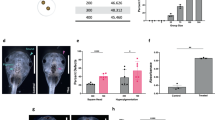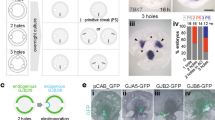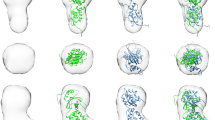Abstract
Arising from: D. Ben-Zvi et al. Nature 453, 1205–1211 (2008)10.1038/nature07059; Francois et al. reply
Metazoan organisms can ‘scale’, that is, maintain similar proportions regardless of size. Ben-Zvi et al.1 use experiments in Xenopus to support a quantitative model that explains morphological scaling as the result of scaling of a gradient of bone morphogenetic protein (BMP) signals. We believe that the evidence for scaling in Xenopus is misinterpreted, and that their model for embryonic patterning disagrees with prior data. The experiments they present supporting their model admit alternative interpretations.
Similar content being viewed by others
Enjoying our latest content?
Log in or create an account to continue
- Access the most recent journalism from Nature's award-winning team
- Explore the latest features & opinion covering groundbreaking research
or
References
Ben-Zvi, D., Shilo, B., Fainsod, A. & Barkai, N. Scaling of the BMP activation gradient in Xenopus embryos. Nature 453, 1205–1211 (2008)
Kageura, H. & Yamana, K. Pattern regulation in defect embryos of Xenopus laevis. Dev. Biol. 101, 410–415 (1984)
Gerhart, J. Changing the axis changes the perspective. Dev. Dyn. 225, 380–383 (2002)
Cooke, J. Scale of body pattern adjusts to available cell number in amphibian embryos. Nature 290, 775–778 (1981)
Kinoshita, T., Jullien, J. & Gurdon, J. B. Two-dimensional morphogen gradient in Xenopus: boundary formation and real-time transduction response. Dev. Dyn. 235, 3189–3198 (2006)
Faure, S., Lee, M. A., Keller, T., ten Dijke, P. & Whitman, M. Endogenous patterns of TGFbeta superfamily signaling during early Xenopus development. Development 127, 2917–2931 (2000)
Schohl, A. & Fagotto, F. Beta-catenin, MAPK and Smad signaling during early Xenopus development. Development 129, 37–52 (2002)
Tucker, J. A., Mintzer, K. A. & Mullins, M. C. The BMP signaling gradient patterns dorsoventral tissues in a temporally progressive manner along the anteroposterior axis. Dev. Cell 14, 108–119 (2008)
Reversade, B., Kuroda, H., Lee, H., Mays, A. & De Robertis, E. M. Depletion of Bmp2, Bmp4, Bmp7 and Spemann organizer signals induces massive brain formation in Xenopus embryos. Development 132, 3381–3392 (2005)
Reversade, B. & De Robertis, E. Regulation of ADMP and BMP2/4/7 at opposite embryonic poles generates a self-regulating morphogenetic field. Cell 123, 1147–1160 (2005)
Marom, K., Levy, V., Pillemer, G. & Fainsod, A. Temporal analysis of the early BMP functions identifies distinct anti-organizer and mesoderm patterning phases. Dev. Biol. 282, 442–454 (2005)
Williams, P. H., Hagemann, A., Gonzalez-Gaitan, M. & Smith, J. C. Visualizing long-range movement of the morphogen Xnr2 in the Xenopus embryo. Curr. Biol. 14, 1916–1923 (2004)
Oelgeschlager, M., Kuroda, H., Reversade, B. & De Robertis, E. M. Chordin is required for the Spemann organizer transplantation phenomenon in Xenopus embryos. Dev. Cell 4, 219–230 (2003)
Meinhardt, H. Organizer and axes formation as a self-organizing process. Int. J. Dev. Biol. 45, 177–188 (2001)
Solnica-Krezel, L. Vertebrate development: taming the nodal waves. Curr. Biol. 13, R7–R9 (2003)
Author information
Authors and Affiliations
PowerPoint slides
Rights and permissions
About this article
Cite this article
Francois, P., Vonica, A., Brivanlou, A. et al. Scaling of BMP gradients in Xenopus embryos. Nature 461, E1 (2009). https://doi.org/10.1038/nature08305
Received:
Accepted:
Issue date:
DOI: https://doi.org/10.1038/nature08305
This article is cited by
-
Scale-invariant patterning by size-dependent inhibition of Nodal signalling
Nature Cell Biology (2018)
-
Dynamic scaling of morphogen gradients on growing domains
Nature Communications (2014)



